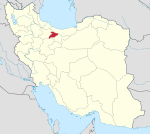Sarhadabad, Alborz
Appearance
Sarhadabad
Persian: شهرک مهندسی زراعی | |
|---|---|
Village | |
 Sarhadabad | |
| Coordinates: 35°45′59″N 51°00′42″E / 35.76639°N 51.01167°E[1] | |
| Country | Iran |
| Province | Alborz |
| County | Fardis |
| District | Central |
| Rural District | Vahdat |
| Population (2016)[2] | |
• Total | 3,617 |
| Time zone | UTC+3:30 (IRST) |
Sarhadabad (Persian: سرحدآباد) is a village in Vahdat Rural District of the Central District of Fardis County, Alborz province, Iran.
History
[edit]In 2010, Karaj County was separated from Tehran province in the establishment of Alborz province.[3]
In 2013, the city of Meshkin Dasht, the Fardis neighborhood[a] in the city of Karaj, and other parts of the county were separated from it in establishing Fardis County, and Vahdat Rural District was created in the new Central District.[4]
Demographics
[edit]Population
[edit]At the time of the 2016 National Census, the village's population was 3,617 people in 1,157 households. It was the only village in its rural district.[2]
See also
[edit]Notes
[edit]References
[edit]- ^ OpenStreetMap contributors (17 August 2024). "Sarhadabad, Fardis County" (Map). OpenStreetMap (in Persian). Retrieved 17 August 2024.
- ^ a b Census of the Islamic Republic of Iran, 1395 (2016): Alborz Province. amar.org.ir (Report) (in Persian). The Statistical Center of Iran. Archived from the original (Excel) on 28 January 2020. Retrieved 19 December 2022.
- ^ Larijani, Ali (2010) [Approved 16 April 1389]. Alborz province establishment law. lamtakam.com (Report) (in Persian). Guardian Council. Notification 412/30588. Archived from the original on 16 December 2023. Retrieved 21 August 2024 – via Lam ta Kam.
- ^ a b Rahimi, Mohammad Reza (1 July 2013) [Approved 29 March 1392]. Approval letter regarding country divisions in Alborz province. rc.majlis.ir (Report) (in Persian). Ministry of the Interior, Council of Ministers. Notification 84917/T49173H. Archived from the original on 26 July 2013. Retrieved 21 August 2024 – via The Research Center of the Islamic Council of Iran.


